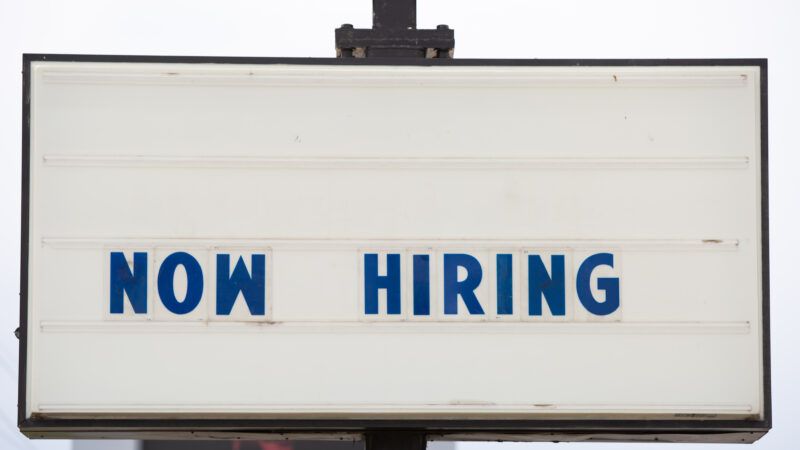Let Immigrants Take the Jobs American Workers Don't Want
The H-2B visa allows foreign workers to fill jobs that native-born Americans aren't interested in.

The country's latest jobs report, released Friday, suggests that about 5.75 million more workers are sitting out of the workforce than before the pandemic. That's in spite of a record 8.1 million job openings recorded at the end of March.
American workers have not been quick to take these jobs for a variety of reasons, including child care considerations, concerns about disease risk, and a reluctance to give up unemployment benefits. But there are plenty of other people who could fill those positions—if only they were here.
David J. Bier, an immigration research fellow at the Cato Institute, suggested that foreign workers be allowed to fill available roles and ease the labor shortage. The government can use the H-2B visa, he argues, to bring willing workers to the U.S.
The H-2B program grants visas to temporary, non-agricultural laborers "if unemployed persons capable of performing such service or labor cannot be found" in the U.S. Around 40 percent of H-2B workers are landscapers or groundskeepers, followed by forestry laborers at 8 percent. Smaller shares perform recreation, housekeeping, construction, and restaurant jobs. These workers can be employed in the U.S. for up to nine months, with possible extensions of up to three years.
The jobs often taken by H-2B workers overlap heavily with the jobs that are now unfilled. March data from the Bureau of Labor Statistics showed the largest increase in openings in the accommodation and food services sector, at 185,000 new jobs. Arts, entertainment, and recreation, another major H-2B sector, saw an increase of 81,000 positions.
"Unemployed Americans don't want to take seasonal manual labor jobs that H-2B workers are hired for," Bier says. "Unemployed Americans want permanent jobs with good working conditions." Though Americans on unemployment are often referred to H-2B-relevant jobs by state agencies, Bier says that workers who "might apply or show up for a day and then quit" are a persistent problem. Employers could save time and resources by hiring H-2B workers.
Many argue that the unwillingness to return to work stems from low wages. But pay is rising across the understaffed sectors (and in the private sector more generally). In the leisure and hospitality sector, which includes restaurant, hotel, and bar jobs, wages are up nearly 9 percent over the past year. Nonmanagerial workers in those fields now earn an average of $15.87 an hour. People in all nonsupervisory private-sector jobs are making $25.60 an hour on average, up from $25.01 a year ago.
Those wage increases haven't been sufficient to lure Americans back into the labor market, but gains from H-2B employment could. According to Bier, H-2B workers help create better-paying jobs for native-born workers. "Economic research has repeatedly found that when immigrant workers come into an industry, U.S. workers shift to jobs with either better pay, better working conditions, or both," he says.
This comes in the form of complementary employment. Bier explored that idea in a February Cato policy analysis, which found that "H-2B workers increase firms' productivity" and subsequently increase the demand for U.S. workers in more desirable positions. By filling lower-skilled roles with H-2B workers, firms can then create supervisory and administrative positions—jobs Americans might be more willing to take.
Harnessing the program won't require drastic changes to our immigration system, given that we've been bringing H-2B workers here since 1952. But political roadblocks may limit its potential. Though Congress has set the annual H-2B visa cap at 66,000, applications far exceed that number. For example, 98,000 workers sought the 33,000 visas allocated for the first half of 2021. The Department of Homeland Security released an additional 22,000 visas on May 25; by June 3, it had received enough petitions to reach the cap (excluding applicants from Honduras, Guatemala, and El Salvador, who count toward a different limit).
After the disappointing April jobs report, Biden said that the economy's comeback "wouldn't be a sprint, it'd be a marathon." Having campaigned on both immigration reform and economic recovery, the president should think about combining the two. A reluctance to raise the visa cap will keep recovery slow—and keep willing workers away from unfilled jobs.
"It's inexcusable with record job openings and a border crisis" to keep the visa cap low, says Bier. "Forcibly keeping H-2B jobs unfilled doesn't create jobs for Americans who don't want to do them. It does the opposite."

Show Comments (111)